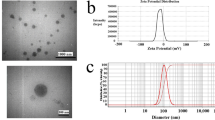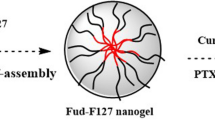Abstract
A number of potent chemopreventives like curcumin and niclosamide have shown promising activities in cancer, although having the drawback of poor bioavailability. To improve the utility of these drugs in cancer therapy, we have encapsulated curcumin and niclosamide in poly(lactic-co-glycolide) (PLGA) nanoparticles, in the presence of poly(vinyl alcohol), using the nanoprecipitation method. We successfully synthesised spherical PLGA nanoparticles, either with each of the single drug individually or with both drugs together, for dual drug loaded samples. FTIR spectroscopy confirmed the successful loading of curcumin and niclosamide in PLGA nanoparticles. The encapsulation efficiency was 48.15% and 70.27% for curcumin and niclosamide, respectively, when loaded individually; which increased to 58.09% for curcumin and 85.36% for niclosamide, with simultaneous dual drug encapsulation. In vitro drug release showed that, as required, a much higher amount of drug released at the acidic pH 6.0 of cancer cells (86.01%, 95.04%, for curcumin and niclosamide, respectively), compared to normal, healthy cell’s pH of 7.4 (25.70% and 60.92% for these two same drugs). MTT assay revealed that dual-drug loaded PLGA nanoparticles exhibited a higher anticancer effect, compared to a bare mixture of two drugs in DMSO (having no PLGA). Therefore, PLGA nanoparticles can be used as an effective carrier to deliver the two hydrophobic drugs to MDA-MB-231 breast cancer cells, for a superior anticancer effect.









Similar content being viewed by others
References
Siegel R, Naishadham D, Jemal A (2013) Cancer statistics, 2013. CA Cancer J Clin 63:11–30
Yallapu MM, Gupta BK, Jaggi M, Chauhan SC (2010) Fabrication of curcumin encapsulated PLGA nanoparticles for improved therapeutic effects in metastatic cancer cells. J Colloid Interface Sci 351:19–29
Pari L, Tewas D, Eckel J (2008) Role of curcumin in health and disease. Arch Physiol Biochem 114:127–149
Bansal SS, Goel M, Aqil F, Vadhanam MV, Gupta RC (2011) Advanced drug-delivery systems of curcumin for cancer chemoprevention. Cancer Prev Res 4:1158–1171
Lu W, Lin C, Roberts MJ et al (2011) Niclosamide suppresses cancer cell growth by inducing Wnt co-receptor LRP6 degradation and inhibiting the Wnt/β-catenin pathway. PLoS One 6:e29290
Liao Z, Nan G, Yan Z, Zeng L, Deng Y, Ye J, Zhang Z, Qiao M, Li R, Denduluri S, Wang J, Wei Q, Geng N, Zhao L, Lu S, Wang X, Zhou G, Luu HH, Haydon RC, He TC, Wang Z (2015) The anthelmintic drug niclosamide inhibits the proliferative activity of human osteosarcoma cells by targeting multiple signal pathways. Curr Cancer Drug Targets 15:726–738
Shureiqi I, Reddy P, Brenner DE (2000) Chemoprevention: general perspective. Crit Rev Oncol Hematol 33:157–167
Park W, Amin ARMR, Chen ZG, Shin DM (2013) New perspectives of curcumin in cancer prevention. Cancer Prev Res 6:387–400
Khan N, Shreaz S, Bhatia R, Ahmad SI, Muralidhar S, Manzoor N, Khan LA (2012) Anticandidal activity of curcumin and methyl cinnamaldehyde. Fitoterapia 83:434–440
Ren X, Duan L, He Q, Zhang Z, Zhou Y, Wu D, Pan J, Pei D, Ding K (2010) Identification of niclosamide as a new small-molecule inhibitor of the STAT3 signaling pathway. ACS Med Chem Lett 1:454–459
Chen H, Yang Z, Ding C, Chu L, Zhang Y, Terry K, Liu H, Shen Q, Zhou J (2013) Discovery of O-alkylamino-tethered niclosamide derivatives as potent and orally bioavailable anticancer agents. ACS Med Chem Lett 4:180–185
Anand P, Kunnumakkara AB, Newman RA, Aggarwal BB (2007) Bioavailability of curcumin: problems and promises. Mol Pharm 4:807–818
Sharma RA, Steward WP, Gescher AJ (2007) Pharmacokinetics and pharmacodynamics of curcumin. The molecular targets and therapeutic uses of curcumin in health and disease. Springer, In, pp 453–470
Elkihel L, Loiseau PM, Bourass J, Gayral P, Letourneux Y (1994) Synthesis and orally macrofilaricidal evaluation of niclosamide lymphotropic prodrugs. Arzneimittelforschung 44:1259–1264
Navab M, Ruchala P, Waring AJ, Lehrer RI, Hama S, Hough G, Palgunachari MN, Anantharamaiah GM, Fogelman AM (2009) A novel method for oral delivery of apolipoprotein mimetic peptides synthesized from all L-amino acids. J Lipid Res 50:1538–1547
Kunwar A, Barik A, Pandey R, Priyadarsini KI (2006) Transport of liposomal and albumin loaded curcumin to living cells: an absorption and fluorescence spectroscopic study. Biochim Biophys Acta - Gen Subj 1760:1513–1520
Hardiansyah A, Destyorini F, Irmawati Y et al (2019) Characterizations of doxorubicin-loaded PEGylated magnetic liposomes for cancer cells therapy. J Polym Res 26:282
Uekama K, Hirayama F, Irie T (1998) Cyclodextrin drug carrier systems. Chem Rev 98:2045–2076
Kaolaor A, Phunpee S, Ruktanonchai UR, Suwantong O (2019) Effects of β-cyclodextrin complexation of curcumin and quaternization of chitosan on the properties of the blend films for use as wound dressings. J Polym Res 26:43
Kakkar V, Singh S, Singla D et al (2010) Pharmacokinetic applicability of a validated liquid chromatography tandem mass spectroscopy method for orally administered curcumin loaded solid lipid nanoparticles to rats. J Chromatogr B 878:3427–3431
Tiyaboonchai W, Tungpradit W, Plianbangchang P (2007) Formulation and characterization of curcuminoids loaded solid lipid nanoparticles. Int J Pharm 337:299–306
Shaikh J, Ankola DD, Beniwal V, Singh D, Kumar MN (2009) Nanoparticle encapsulation improves oral bioavailability of curcumin by at least 9-fold when compared to curcumin administered with piperine as absorption enhancer. Eur J Pharm Sci 37:223–230
Tsai YM, Chien CF, Lin LC, Tsai TH (2011) Curcumin and its nano-formulation: the kinetics of tissue distribution and blood-brain barrier penetration. Int J Pharm 416:331–338
Azizi M, Farahmandghavi F, Joghataei M et al (2013) Fabrication of protein-loaded PLGA nanoparticles: effect of selected formulation variables on particle size and release profile. J Polym Res 20:110
Wong M-Y, Chiu GNC (2011) Liposome formulation of co-encapsulated vincristine and quercetin enhanced antitumor activity in a trastuzumab-insensitive breast tumor xenograft model. Nanomedicine Nanotechnology, Biol Med 7:834–840
Ahlin P, Jerenec N, Kristl J (2001) Influence of formulation variables on the size of PLGA and PLA nanoparticles prepared by an emulsification-diffusion technique. Sci Pharm 69:S167–S168
Eley JG, Pujari VD, McLane J (2004) Poly (lactide-co-glycolide) nanoparticles containing coumarin-6 for suppository delivery: in vitro release profile and in vivo tissue distribution. Drug Deliv 11:255–261
Win KY, Feng S-S (2005) Effects of particle size and surface coating on cellular uptake of polymeric nanoparticles for oral delivery of anticancer drugs. Biomaterials 26:2713–2722
Panyam J, Zhou W-Z, Prabha S, Sahoo SK, Labhasetwar V (2002) Rapid endo-lysosomal escape of poly (DL-lactide-co-glycolide) nanoparticles: implications for drug and gene delivery. FASEB J 16:1217–1226
Horisawa E, Hirota T, Kawazoe S, Yamada J, Yamamoto H, Takeuchi H, Kawashima Y (2002) Prolonged anti-inflammatory action of DL-lactide/glycolide copolymer nanospheres containing betamethasone sodium phosphate for an intra-articular delivery system in antigen-induced arthritic rabbit. Pharm Res 19:403–410
Cegnar M, Kos J, Kristl J (2004) Cystatin incorporated in poly (lactide-co-glycolide) nanoparticles: development and fundamental studies on preservation of its activity. Eur J Pharm Sci 22:357–364
Vyas SP, Khar RK (2004) Targeted & controlled drug delivery: novel carrier systems. CBS publishers & distributors
Makadia HK, Siegel SJ (2011) Poly lactic-co-glycolic acid (PLGA) as biodegradable controlled drug delivery carrier. Polymers (Basel) 3:1377–1397
Acharya S, Sahoo SK (2011) PLGA nanoparticles containing various anticancer agents and tumour delivery by EPR effect. Adv Drug Deliv Rev 63:170–183
Aggarwal S, Gupta S, Pabla D, Murthy RSR (2013) Gemcitabine-loaded PLGA-PEG immunonanoparticles for targeted chemotherapy of pancreatic cancer. Cancer Nanotechnol 4:145–157
Zhang M, Tang Y, Zhu Z, Zhao H, Yao J, Sun D (2018) Paclitaxel and etoposide-loaded poly (lactic-co-glycolic acid) microspheres fabricated by coaxial electrospraying for dual drug delivery. J Biomater Sci Polym Ed 29:1949–1963
Duan J, Mansour HM, Zhang Y, Deng X, Chen Y, Wang J, Pan Y, Zhao J (2012) Reversion of multidrug resistance by co-encapsulation of doxorubicin and curcumin in chitosan/poly (butyl cyanoacrylate) nanoparticles. Int J Pharm 426:193–201
Li H, Yu H, Zhu C et al (2016) Cisplatin and doxorubicin dual-loaded mesoporous silica nanoparticles for controlled drug delivery. RSC Adv 6:94160–94169
Gan Q, Zhu J, Yuan Y, Liu H, Qian J, Li Y, Liu C (2015) A dual-delivery system of pH-responsive chitosan-functionalized mesoporous silica nanoparticles bearing BMP-2 and dexamethasone for enhanced bone regeneration. J Mater Chem B 3:2056–2066
Narayanan S, Pavithran M, Viswanath A et al (2014) Sequentially releasing dual-drug-loaded PLGA–casein core/shell nanomedicine: design, synthesis, biocompatibility and pharmacokinetics. Acta Biomater 10:2112–2124
Singh PK, Wani K, Kaul-Ghanekar R et al (2014) From micron to nano-curcumin by sophorolipid co-processing: highly enhanced bioavailability, fluorescence, and anti-cancer efficacy. RSC Adv 4:60334–60341
Narayanan K, Subrahmanyam VM, Venkata Rao J (2014) A fractional factorial design to study the effect of process variables on the preparation of hyaluronidase loaded PLGA nanoparticles. Enzyme Res 2014
Singh G, Kaur T, Kaur R, Kaur A (2014) Recent biomedical applications and patents on biodegradable polymer-PLGA. Int J Pharmacol Pharm Sci 1:30–42
Tan HY, Widjaja E, Boey F, Loo SCJ (2009) Spectroscopy techniques for analyzing the hydrolysis of PLGA and PLLA. J Biomed Mater Res Part B Appl Biomater 91:433–440
Sadeghi-Avalshahr A, Nokhasteh S, Molavi AM, Khorsand-Ghayeni M, Mahdavi-Shahri M (2017) Synthesis and characterization of collagen/PLGA biodegradable skin scaffold fibers. Regen Biomater 4:309–314
Ahmadi E, Zarghami N, Jafarabadi MA et al (2019) Enhanced anticancer potency by combination chemotherapy of HT-29 cells with biodegradable, pH-sensitive nanoparticles for co-delivery of hydroxytyrosol and doxorubicin. J Drug Deliv Sci Technol 51:721–735
Xie X, Tao Q, Zou Y, Zhang F, Guo M, Wang Y, Wang H, Zhou Q, Yu S (2011) PLGA nanoparticles improve the oral bioavailability of curcumin in rats: characterizations and mechanisms. J Agric Food Chem 59:9280–9289
Dubey RD, Saneja A, Qayum A et al (2016) PLGA nanoparticles augmented the anticancer potential of pentacyclic triterpenediol in vivo in mice. RSC Adv 6:74586–74597
Van Tonder EC, Mahlatji MD, Malan SF et al (2004) Preparation and physicochemical characterization of 5 niclosamide solvates and 1 hemisolvate. AAPS PharmSciTech 5:86
Mukerjee A, Vishwanatha JK (2009) Formulation, characterization and evaluation of curcumin-loaded PLGA nanospheres for cancer therapy. Anticancer Res 29:3867–3875
Verderio P, Bonetti P, Colombo M et al (2013) Intracellular drug release from curcumin-loaded PLGA nanoparticles induces G2/M block in breast cancer cells. Biomacromolecules 14:672–682
Jain NK, Prabhuraj RS, Bavya MC et al (2019) Niclosamide encapsulated polymeric nanocarriers for targeted cancer therapy. RSC Adv 9:26572–26581
Acknowledgments
We acknowledge the Sophisticated Analytical Instrumental Facility (SAIF) and Industrial Research Consultancy Centre (IRCC), Indian Institute of Technology, Bombay for providing the necessary instrumental facility for successful completion of the work.
Author information
Authors and Affiliations
Corresponding author
Ethics declarations
Conflict of interest
The authors declare no completing financial interest.
Additional information
Publisher’s note
Springer Nature remains neutral with regard to jurisdictional claims in published maps and institutional affiliations.
Electronic supplementary material
ESM 1
(DOCX 111 kb)
Rights and permissions
About this article
Cite this article
R.S., P., Bomb, K., Srivastava, R. et al. Dual drug delivery of curcumin and niclosamide using PLGA nanoparticles for improved therapeutic effect on breast cancer cells. J Polym Res 27, 133 (2020). https://doi.org/10.1007/s10965-020-02092-7
Received:
Accepted:
Published:
DOI: https://doi.org/10.1007/s10965-020-02092-7




